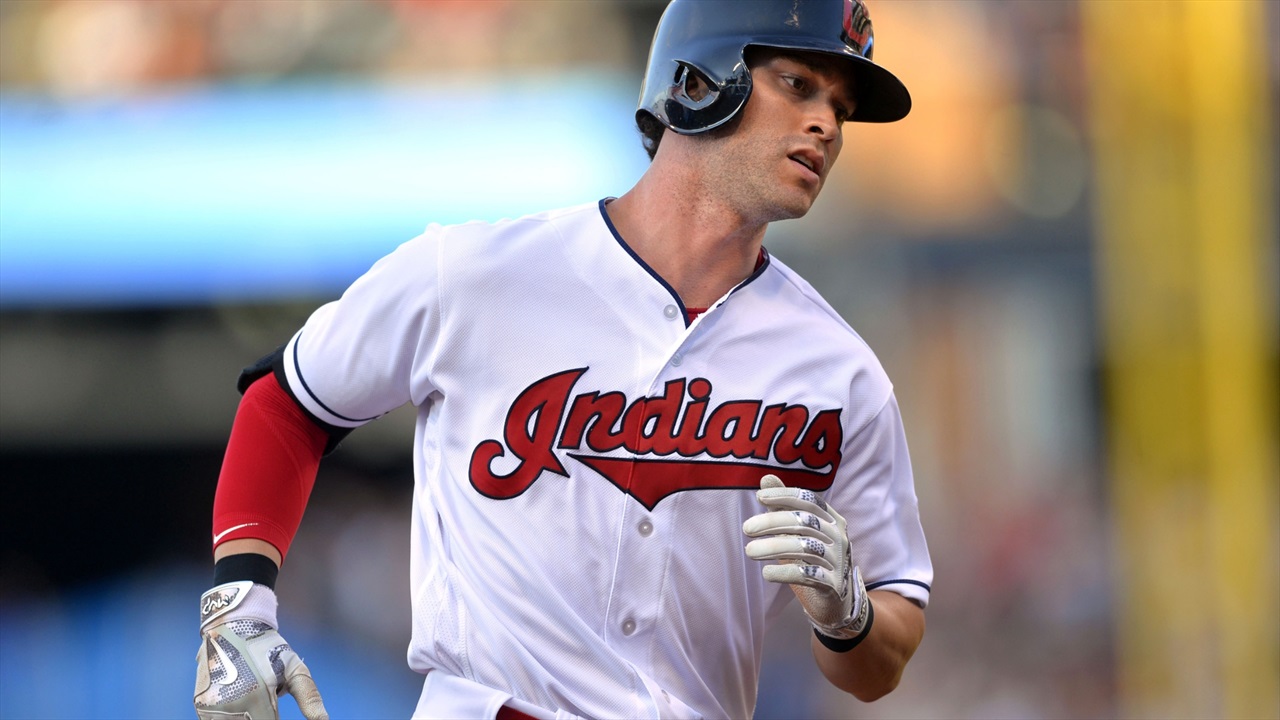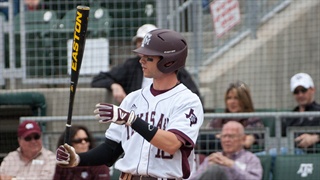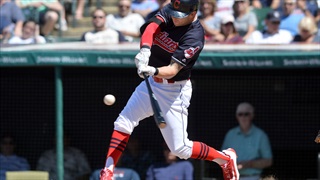
Dugout Chat: Tyler Naquin enters 2018 hungry after injury-plagued year
(Click "play" above to listen to the Dugout Chat in full.)
Tyler Naquin took Major League Baseball by storm in 2016, finishing third in the Rookie of the Year voting after hitting .296 with 14 home runs and playing a solid center field as the Indians fell one game short of winning the World Series.
“It was special, man,” Naquin says of his rookie year. “Being in that organization with Cleveland, they give you every opportunity to be great. If you take advantage of that you’re going to do big things, and I felt the drive and the need to do that.”
His former college coaches weren’t surprised at his excellence in his first taste of the big leagues, though, as Naquin more than proved his ability when he starred at Texas A&M from 2010-2012. He hit at least .380 with more than 90 hits and 27 extra-base hits in each of his last two seasons as an Aggie, leading them to the College World Series in 2011.
“He just loved to play — he loved the moment,” says A&M head coach Rob Childress. “He relished being in the moment whether it was a big hit, a big play, a big assist from the outfield. That guy loved to compete, and that’s what made him what he was during his time at Texas A&M.”
Naquin arrived in College Station as a 155-pound kid with a rocket arm and good instincts in the outfield, but he struggled to hit in the early part of his college career. He still started 58 games as a freshman, however, as the coaching staff decided to keep him in the lineup and let him figure it out at the plate regardless of his numbers.
He finished strong to get his average up to nearly .250 by season’s end, went to work that offseason and then quickly developed into one of the best hitters in A&M history.
“Where he was as a player at the beginning of his freshman year to the end of his sophomore year is about as big of a jump as any player I’ve been around. At the front of his freshman year we knew who he was, but he didn’t know who he was,” says A&M assistant coach Justin Seely. “He always played really good defense, he never backed down from the challenge, he always believed in himself and he always brought the same excited attitude to the ballpark. Not a whole lot has changed, that’s just who he is.”
That improvement can be chalked up to nothing but good old-fashioned hard work. He picked up his indefatigable work ethic from his parents — his dad works in construction and his mom is a breast cancer survivor — and his brother, who also works in construction now.
“Grit is something you can’t teach,” Naquin says. “Just watching the way my dad and brother work, and my mom is a two-time breast cancer survivor. My dad’s been tearing out wood floors for 45 years, that’s about as blue-collar as it gets.
“There ain’t no handouts. If you want something you’d better go get it. I don’t believe in handouts, I don’t believe in participation trophies. If you want something you better go get it and if you don’t, it’s nobody’s fault but yours.”
Says Seely: “He’s always motivated — that’s just who he is, that doesn’t change. He’s a very driven person, very meticulous with what he does. If he’s going to do something, he’s going to do it. There’s not going to be any one foot in with him. I would expect great success from him this year.”
Another attribute on the field that always stood out about Naquin was his arm strength. Not only does he possess the strongest outfield arm of the Rob Childress era, if not longer, but he is also extremely accurate, a combination that is rare at the college level.

That arm strength is not something he developed overnight, but through the hours and hours he spent as a youngster throwing rocks and other objects into the creek with his brother and buddies while growing up in Klein.
“I can’t tell you how many waterlogged baseballs, rocks, footballs, everything, we threw,” Naquin recalls. “Weathered or not weathered, we were just trying to back up and see how far we could throw it.”
Says Childress: “His arm strength and accuracy is the best I’ve ever coached. Maybe we’ve had some guys with that arm strength, but they weren’t as accurate as Tyler. He could really, really throw it and throw it where he wanted.”
All of Naquin’s college success set the stage for him to break out as a big-leaguer. Picked in the middle of the first round by the Indians in 2011, Naquin did nothing but hit line drives, rack up extra-base hits and steal double-digit bases in his journey up the minor league ladder.
Then, in his rookie year, he experienced a power surge as he hit more than 10 home runs in a season for the first time in his career and slugged a robust .514 — a higher slugging percentage than Kris Bryant recorded when he won the Rookie of the Year in 2015. That power stroke was another example of Naquin always looking for ways to improve his game.
He could always hit line drives from foul pole to foul pole as an Aggie, but then he added some more extra-base power as a sophomore and junior. Similarly, he was always a fast runner, but he was never a prolific base-stealer until his junior year, when he swiped 21 bags.
Naquin says as he has gotten older, he has learned to use his legs more in his swing to generate more power, and the fact that he has added about 40 pounds of muscle since he got to college helps as well.
“His ability to square the baseball up is as good as anyone I’ve been around,” Seely says. “As long as he squares it up routinely he’s going to hit home runs in the big leagues.”

Heading into his third big-league season, Naquin — relentlessly determined to begin with — is hungrier than ever. He struggled out of the gate in 2017, then battled through back and knee injuries. He played 19 games for the Indians and 80 for Triple-A Columbus, where he hit a very solid .298 with 10 homers, 14 doubles and four triples.
Naquin split his offseason work between College Station and Fairchild Sports Performance in Houston, where former A&M studs Ross Stripling and Daniel Mengden, as well as MLB stars George Springer and Anthony Rendon, work out.
“I had to do some recovery and was able to still put up numbers in the minor leagues, but now we’re here and I feel good,” Naquin says. “I’ve been rehabbing and I’m ready to go.”
The Indian position players reported to Spring Training on February 18, as the 26-year-old outfielder will try to recreate his rookie production and contribute for a talented Cleveland team with the potential to make a deep October run.
“I just want to stay healthy and help the team,” Naquin says. “I know if I’m healthy I can do big things out there. When you can help the team, that’s a rewarding feeling.”
